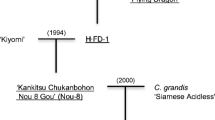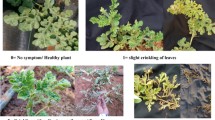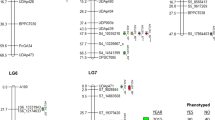Abstract
Citrus tristeza virus (CTV) has caused the death of millions of trees grafted on sour orange (Citrus aurantium). However, this rootstock is very well adapted to the Mediterranean, semi-arid conditions. The aim of the present research is to genetically analyze the accumulation of CTV in a progeny derived from the cross between C. aurantium and Poncirus trifoliata, both resistant to CTV isolate T-346. Graft propagation of 104 hybrids was done on healthy sweet orange as a rootstock. Three months later, each rootstock was graft inoculated with two patches of infected tissue (isolate T-346). One, 2, and sometimes, 3 and 4 years after inoculation, hybrids and infected patches were tested for CTV by tissue-blot immuno-assay. Additionally, CTV multiplication was evaluated every year as the optical density of double-antibody sandwich enzyme-linked immuno-sorbent assay reactions. Linkage maps for P. trifoliata based on 63 markers, and for C. aurantium based on 157 markers, were used. Most molecular markers were microsatellites and IRAP (inter-retrotransposon amplified polymorphisms). Some analogues of resistance and expressed sequences were also included for candidate gene analysis.
Resistance against CTV was analyzed as a quantitative trait (CTV accumulation) by QTL (quantitative trait loci) analysis to avoid the assumption of monogenic control. Three major resistance QTLs were detected where the P. trifoliata resistance gene, Ctv-R, had been previously located in other progenies. Up to five minor QTLs were detected (Ctv-A 1 to Ctv-A 5 ). A significant epistatic interaction involving Ctv-R 1 and Ctv-A 1 was also found. An analogue of a resistance gene is a candidate for Ctv-A 3 , and two expressed sequences are candidates for Ctv-A 1 and Ctv-A 5 . Single-strand conformational polymorphism analysis of CTV genes QTL P20 and P25 (coat protein) in susceptible hybrids, was carried out to test whether or not any QTL accumulation was a defeated resistance gene. Since the same haplotype of the virus was visualized independently on the CTV titer, differences in the amount of virions are not explained through the selection of CTV genotypes by the host, but through differences among citradias in CTV replication and/or movement.






Similar content being viewed by others
References
Albiach-Martí MR, Grosser JW, Hilf ME, Gowda S, Mawassi M, Satyanarayana T, Garnsey SM, Dawson WO (1999) CTV resistant plants are not immune to CTV at the cellular level. Proc 18th Annual Meeting of the American Society for Virology 192
Asíns MJ (2002) Present and future of quantitative trait locus analysis in plant breeding. Plant Breed 121:281–291
Ayllon MA, Rubio L, Moya A, Guerri J, Moreno P (1999) The haplotype distribution of two genes of citrus tristeza virus altered after host change of aphid transmission. Virology 255:32–39
Bassanezi RB, Bergamin-Filho A, Amorim L, Gimenes-Fernandes N, Gottwald TR, Bové JM (2003) Spatial and temporal analyses of citrus sudden death as a tool to generate hypothesis concerning its etiology. Phytopathology (in press)
Bar-Joseph M, Lee RF (1989) Citrus tristeza virus: descriptions of plant viruses no. 353. Assoc App Biol, Wellsbourne, UK
Basten CJ, Weir BS, Zeng Z-B (2002) QTL Cartographer, Version 1.17. Department of Statistics, North Carolina State University, Raleigh, USA
Bent AF (1996) Plant disease resistance genes: function meets structure. Plant Cell 8:1757–1771
Bernet GP, Asins MJ (2003) Identification and genomic distribution of gypsy like retrotransposons in Citrus and Poncirus. Theor Appl Genet (in press)
Bernet GP, Bretó MP, Asins MJ (2003) Expressed sequence enrichment of linkage group 4 for candidate gene analysis of citrus tristeza virus resistance. Theor Appl Genet: DOI 10.1007/s00122-003-1479-6
Cambra M, Camarasa E, Gorris MT, Garnsey SM, Gumpf DJ, Tsai MC (1993) Epitope diversity of citrus tristeza virus isolates in Spain. In: Proc 12th Conf IOCV, Riverside, California, USA, pp 33–38
Dawson WO, Hilf ME (1992) Host-range determinants of plant viruses. Annu Rev Plant Physiol Plant Mol Biol 43:527–555
Deng Z, Tao Q, Chang YL, Huang S, Ling P, Yu C, Chen C, Gmitter FG, Zhang HB (2001) Construction of a bacterial artificial chromosome (BAC) library for citrus and identification of BAC contigs containing resistance-gene candidates. Theor Appl Genet 102:1177–1184
Fang DQ, Federici CT, Roose ML (1998) A high-resolution linkage map of the citrus tristeza virus resistance gene-region in Poncirus trifoliata (L.) Raf. Genetics 150:883–890
Garnsey SM, Pemar TA, Cambra M, Henderson CT (1993) Direct tissue-blot immunoassay (DTBIA) for detection of citrus tristeza virus (CTV). In: Moreno P, Da Graça JV, Timmer LW (eds) Proc 12th Conf Int Organiz Citrus Virol, IOCV, Riverside, California, pp 39–50
Gmitter FG, Xiao SY, Huang S, Hu XL, Garnsey SM, Deng Z (1996) A localized linkage map of the citrus tristeza virus resistance-gene region. Theor Appl Genet 92:688–695
Grattapaglia D, Bertolucci FLG, Penchel R, Sederoff R (1996) Genetic mapping of quantitative trait loci controlling growth and wood quality traits in Eucalyptus grandis using a maternal half-sib family and RAPD markers. Genetics 144:1205–1214
Hammond-Kosack K, Jones JDG (1997) Plant disease resistance genes. Annu Rev Plant Physiol Mol Biol 48:575–607
Li ZK Luo LJ, Mei H, Paterson AH, Zhao XH, Zhoung DB, Wang YP, Yu XQ, Zhu L, Tabien R, Stansel JW, Ying CS (1999) A defeated rice resistance gene acts as a QTL against a virulent strain of Xanthomonas oryzae pv oryzae. Mol Gen Genet 261:58–63
Ling P, Duncan LW, Deng Z, Dunn D, Xu X, Huang S, Gmitter FG (2000) Inheritance of citrus nematode resistance and its linkage with molecular markers. Theor Appl Genet 100:1010–1017
Martin GB, Brommonschenkel SH, Chunwongse J, Frary A, Ganal MW, Spivey R, Wu T, Earle ED, Tanksley SD (1993) Map-based cloning of a protein kinase gene conferring disease resistance in tomato. Science 262:1432–1436
Mestre PF, Asíns MJ, Pina JA, Carbonell EA, Navarro L (1997a) Molecular markers flanking the citrus tristeza virus resistance gene from Poncirus trifoliata (L.) Raf. Theor Appl Genet 94:458–464
Mestre PF, Asíns MJ, Carbonell EA, Navarro L (1997b) New gene(s) involved in the resistance of Poncirus trifoliata (L.) Raf. to citrus tristeza virus. Theor Appl Genet 95:691–695
Roossinck MJ (1997) Mechanisms of plant virus evolution. Annu Rev Phytopathol 35:191–209
Ruiz C, Asíns MJ (2003) Comparison between Poncirus and Citrus genetic linkage maps. Theor Appl Genet 106:826–836
Salmeron JM, Oldroyd GED, Rommens CMT, Scofield SR, Kim HS (1996) Tomato PRF is a member of the leucine-rich repeat class of plant disease resistance genes and lies embedded within the Pto kinase gene cluster. Cell 86:123–33
Takken FLW, Joosten MHAJ (2000) Plant resistance genes: their structure, function and evolution. Eur J Plant Pathol 106:699–713
Van der Biezen EA, Jones JDG (1999) Plant disease-resistance proteins and the gene-for-gene concept. Trends Biochem Sci 23:454–456
Van der Vossen EG, van der Voort JR, Kanyuka K, Bendahmane A, Sandbrink H, Baulcombe DC, Bakker J, Stiekema WJ, Klein-Lankhorst RM (2000) Homologues of a single resistance-gene cluster in potato confer resistance to distinct pathogens: a virus and a nematode. Plant J 23:567–576
Van Ooijen JW, Maliepaard C (1996) MapQTL version 3: software for the calculation of QTL positions on genetic maps. CPRO-DLO, Wageningen
Van Ooijen JW, Voorrips RE (2001) JoinMap 3.0, Software for the calculation of genetic linkage maps. Plant Research International, Wageningen, The Netherlands
Yang Z-N, Ye X-R, Choi S, Molina J, Moonan F, Wing RA, Roose ML, Mirkov TE (2001) Construction of a 1.2-Mb contig including the citrus tristeza virus resistance gene locus using a bacterial artificial chromosome library of Poncirus trifoliata (L.) Raf. Genome 44:382–393
Zeng ZB (1994) The precision mapping of quantitative trait loci. Genetics 136:1457–1468
Acknowledgments
This work was supported in part by grants from Conselleria de Cultura, Educació i Ciència (GPB), INIA (SC99-047) and MCYT (AGL2002-02395). Authors thank J. Puchades, M. Boil and J. Piquer for technical assistance.
Author information
Authors and Affiliations
Corresponding author
Additional information
Communicated by C. Möllers
Rights and permissions
About this article
Cite this article
Asins, M.J., Bernet, G.P., Ruiz, C. et al. QTL analysis of citrus tristeza virus-citradia interaction. Theor Appl Genet 108, 603–611 (2004). https://doi.org/10.1007/s00122-003-1486-7
Received:
Accepted:
Published:
Issue Date:
DOI: https://doi.org/10.1007/s00122-003-1486-7




